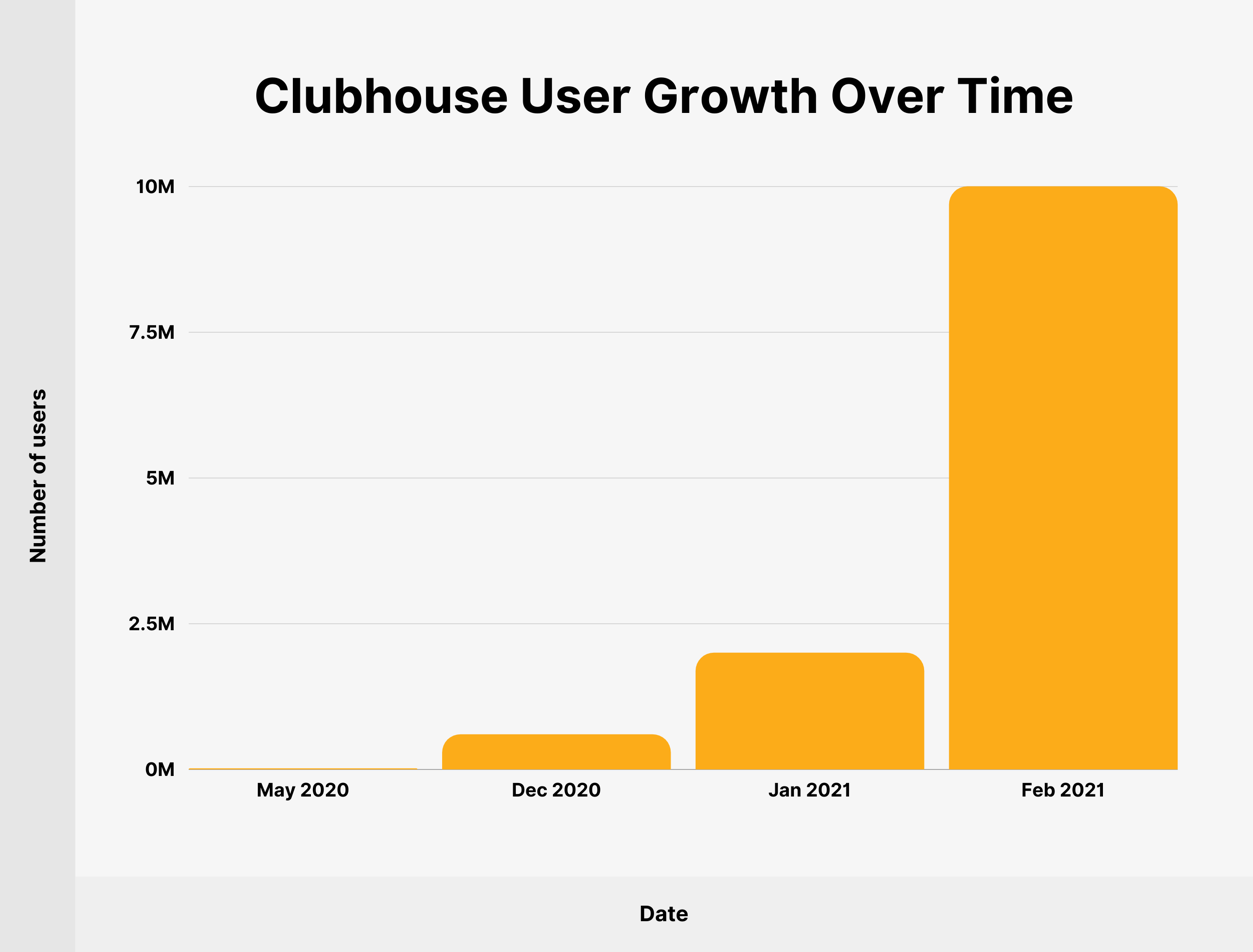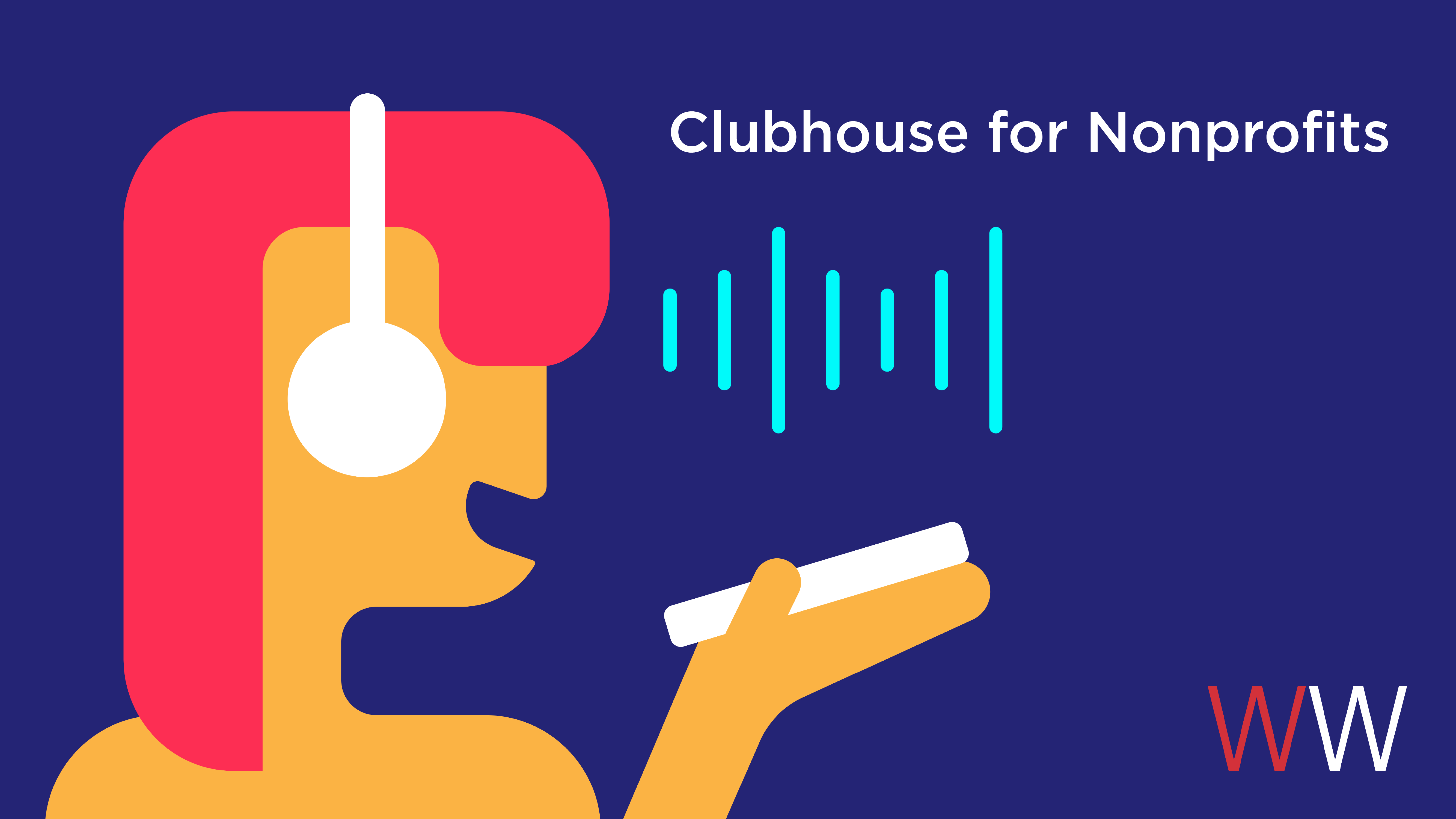By: Glaelis Sierra – Account Director at Williams Whittle
Social media networks continue to grow and evolve. Data from Global Web Index shows that 56% of the world’s population uses social media and the average daily usage is 2 hours and 25 minutes. Today, in the U.S. 72% of the public uses some type of social media, according to a report from Pew Research Center.
So, it’s no surprise that new channels continue to arise in this evolving category. A social media platform that emerged recently is Clubhouse – an audio-based social media app that allows people to speak on topics, tell stories, share ideas and meet people (including celebrities) from around the world. We wrote a blog with full details on this platform, how it works and the basics of how to use it.
As of February 2021, Clubhouse had 10 million active users, according to a town hall meeting hosted by their CEO.

Source: Backlinko
How your nonprofit can get started on Clubhouse:
- Find your speakers: For now, Clubhouse does not enable “company” accounts — it’s only for individuals. Find someone in your organization who is interested in joining and be your organization’s spokesperson. Make sure this person has a passion for driving conversations on your mission’s behalf.
- Join the Club(s): Once you have a designated spokesperson, find related topics, clubs, and influencers to follow. It takes little time to get used to how the platform works, given that conversations happen in real-time, and only a few are recorded for later use.
- Join the Conversation: Jump into conversations that relate to your organization and to your mission. Find out who is moderating, who is attending, and who is asking questions. Contribute to the conversation, ask questions, connect with attendees, and build your network.
- Start the Conversation: Once you’re familiarized with the platform, you can start your own room — either scheduled for a later date or start a spontaneous conversation.
Last February, Harold Hughes, an early Clubhouse adopter, hosted a room to raise money to help his neighbors in Texas during the worst winter storm in recent history. What started out as a single fundraiser turned into a week-long initiative called “Clubhouse Loves Texas”. Organized and promoted by some of the app’s biggest influencers, the events varied from performances and conversations with celebrities to a book club and a doctor’s roundtable. By May 4, 2021, the initiative had raised more than $146K for several Texas organizations.
Since Clubhouse doesn’t offer in-app linking, they set up the fundraiser through Pledge, which allows users to donate by texting. Then, they created graphics to overlay their profile pictures, which included the text-do-donate information. Also, Hughes used Twitter to promote the rooms. This is important for the success of any room – using other social media channels to promote your Clubhouse room.
Because it is still in Beta mode, it is not available to the general public without a specific invite. However, if you’re an iPhone user, you can download the app and reserve a username until you receive an invite. According to Newsweek, some people have turned to eBay to sell Clubhouse invites for hundreds of dollars – that’s how much people want to be on this platform.
Once you’ve gained access to the platform, your organization can use it in any of these 6 ways –
- Build relationships – this app is great to build business connections. Think of it instead of exchanging business cards, you can exchange social media handles, website information, business emails, etc.
- Test ideas – you can test ideas for content. Once you build a room, you can pitch ideas and see how the room reacts to them. Or you can join a room in your field and test your ideas there as well.
- Brand awareness – you can highlight your organization’s mission and educate those in the room about the programs and services you offer.
- Storytelling – share stories that highlight the impact of your organization.
- Stand out as an expert – this app allows users to stand out as experts in specific topics as they’re promoted to speakers and moderators. The more trust you can build, could lead to new supporters and potential new donors.
- Fundraising – The Clubhouse for Texas story proved this platform can be successful for fundraising, as long as you’re promoting it on the rest of your social media channels.
For nonprofit organizations that are looking to expand their reach, lead the conversation about their industry and their cause, plus find new ways to engage with their supporters, Clubhouse could be a great fit. This platform offers a way to cultivate a strong sense of community engagement.
There are plenty of rooms for every topic you can think of – animal welfare, environment, faith-based, political, poverty, LGBTQ+, etc. Drop into rooms, listen to conversations, ask questions and share experiences/information. Find ways to connect your organization with other people in your field and potential supporters.
In this time of mass social isolation and screen fatigue due to the COVID-19 pandemic, it seems like the future of social media is all about audio. Twitter has its own version of sound-based social, called Twitter Spaces, which is now available to anyone with 600 or more followers.
Facebook announced that Live Audio Rooms will be available to everyone by summer 2021. They are also currently working on an audio creation tool called Soundbites. Mark Zuckerberg has described these as “snackable” audio content – a place for jokes, poems, brief insights, or anecdotes that go into an algorithmic feed.
Reddit Talk was recently announced as well. This is a new feature on Reddit that allows users to host live audio conversations in their communities. For now, they’re testing this new feature and users are being asked to join a waitlist to be advised once it’s ready to use.
LinkedIn has also confirmed they are working on an audio experience in their app. They believe its audio networking feature will be different because it will be connected with users’ professional identity, not just a social profile like the rest of these audio-based apps.
As you can see, audio social networking is here to stay. Nonprofit organizations need to review their social media strategies to make sure each channel is working and achieving its goals.
Are you on Clubhouse already? Contact us today to design a social media strategy that works for your nonprofit organization and effectively reaches your target audience.



